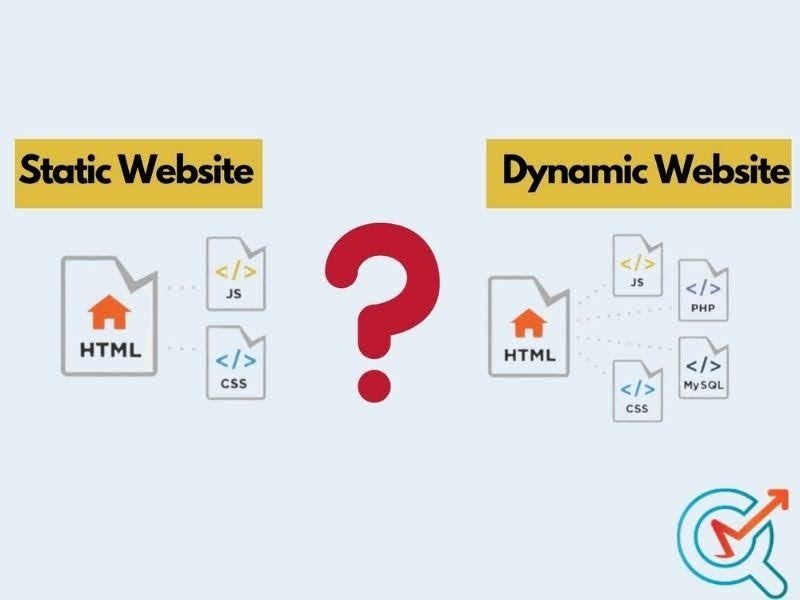
Learn how to distinguish between static and dynamic websites easily
Struggling to understand the difference between static and dynamic website examples? You're not alone! Static websites stay the same, showing fixed content every time you visit. Dynamic websites, on the other hand, change based on your actions or updates. Want to learn more about these types of websites and see some examples? Check out our full article for a simple guide that makes it all clear!
We’ve summarized some key differences between static and dynamic website examples in the table below. Take a look to get a better understanding!
Factors | Static Website | Dynamic Website |
Code Generation | The code is pre-written and stays the same unless manually updated | The code is generated in real-time whenever a page is accessed |
User Customization | The content is fixed and doesn’t change based on the visitor | The content can change depending on the visitor’s information, like location or preferences |
Database Usage | Doesn’t rely on a database; all content is hardcoded into the site | Uses a database to store and retrieve data |
Content Management Interface | No built-in tools for non-technical users to manage content | Provides tools that allow non-technical users to easily update content |
Written language | HTML, JavaScript, CSS, etc | CGI, AJAX, ASP, ASP.NET, etc |
Code Updates | Every small change requires manually updating the code on each page | A single update can automatically change multiple pages across the site |
Error Probability | Fewer chances of errors since the structure is simpler | More complex, so there are higher chances of bugs or issues occurring |
Security | Generally more secure because it doesn’t involve complex interactions or databases | Less secure as it involves more complex code and connects to a database |
Overview of Static Website

Static websites are simple, fast-loading, and display fixed content consistently
A static website consists of fixed files (HTML, CSS, JavaScript) stored on a web server. These files are client-side, meaning they run in your browser. The server sends the same content to every visitor, so the website remains the same for all users. To change the site, you need to manually update the files.
Although static websites don’t update automatically, they can still be interactive, with buttons, images, videos, forms, and animations using CSS or JavaScript. However, all visitors will see the same content each time they visit.
Types of Static Websites
Here are some common types of static content:
Images: Photos or illustrations on websites that stay the same unless edited by the owner.
Text Content: Written content like articles, FAQs, or company descriptions that are rarely updated.
Videos on Online Platforms: Non-interactive videos that are for viewing only, without user interaction.
Infographics: Visuals that remain fixed unless updated by the website owner.
Blogs & Website Content: Content published through CMS that remains static until the owner decides to update it.
eCommerce Pages: Product pages, descriptions, and pricing on online stores that are managed by admins.
Website Landing Pages: Static pages like "About Us" and "Services" that offer fixed information to visitors.
Pros & Cons of Static Websites

Static websites are fast and secure, but harder to update dynamically
Pros of Static Website Examples:
Fast Loading: Static websites load quickly because the code is ready and doesn't need a database to fetch data.
Easy Setup: If the site has few pages, developers can set it up easily.
Handles More Traffic: Static websites can handle many visitors without crashing, since the server only serves the same code to all users.
More Secure: Without a database, static websites are less likely to be hacked, as there are fewer points of attack.
Fewer Errors: Since there is no database involved, static websites tend to have fewer technical problems.
Cheaper Hosting: Static websites require less storage and bandwidth, so they cost less to host.
Cons of Static Website Examples:
No Personalization: Static websites can’t show different content based on user preferences or location.
Hard to Update: If you have many pages, making changes across the whole site can take a lot of time and may need a developer.
No Visitor Data: You can’t easily collect or store visitor details because there is no database.
Hard to Manage Content: Adding new content or pages is not as simple as with dynamic websites. It usually requires a developer or specific tools.
Overview of Dynamic Website

Dynamic websites offer interactive content, real-time updates, and personalized experiences
A dynamic website shows different content to different visitors based on factors like location, time, preferences, or actions (e.g., shopping habits). This makes the experience more personalized. Unlike static websites, dynamic sites don't store pages as HTML files. Instead, the server creates the page when requested by pulling data from databases and building a custom page. This allows for more flexibility and a unique experience for each user.
Types of Dynamic Websites:
Dynamic content refers to website elements that can be easily updated or modified by users. Common types include:
Chatbots: Provide real-time responses to user questions.
Social Media: Users create, view, and interact with content.
eCommerce Pages: User-generated content like reviews and recommendations.
Digital Ads: Ads that allow user interaction.
User-Generated Content (UGC): Reviews, ratings, and forum posts created by users.
Personalized Content: Tailored content based on user behavior or preferences.
Pros & Cons of Dynamic Website

Dynamic websites provide interactivity but require more maintenance and resources
Pros of Dynamic Website Examples:
Personalized Content: Dynamic websites can change their content based on the user’s location, preferences, or previous actions, making the experience more tailored to each visitor.
Easy to Manage: With a CMS like WordPress, even people without coding skills can easily create and manage pages or posts on the site.
Add Functions Easily: Dynamic sites allow you to add new features (like contact forms or shopping carts) without needing to write any code. You can use plugins to add these functions quickly.
Scalability: You can add a lot of content or products easily without needing to change the code. This is helpful for large sites like e-commerce stores or blogs.
Cons of Dynamic Website Examples:
Slower Loading: Dynamic websites are slower because they generate content for each visitor, which takes time to process.
Security Risks: Since dynamic sites interact with databases and can accept data from users, they are more vulnerable to hacking, especially if plugins are not kept up to date.
Higher Hosting Costs: Dynamic websites need more resources, like bandwidth, which makes hosting more expensive, especially if you get a lot of traffic.
Static Website Examples

Static website examples include blogs, portfolios, and informational landing pages
Dropbox
Dropbox’s homepage is a great static website example. It provides fixed information about their cloud storage services, with minimal interaction except for sign-up options.
ReactJS
ReactJS.org is a static website that provides detailed documentation, tutorials, and resources for developers using React. It is a powerful JavaScript library for building user interfaces, especially for single-page applications (SPAs).
W3Schools
W3Schools is an online educational platform with a mostly static structure. It provides tutorials and references with content that is updated periodically but largely remains fixed.
The Mozilla Developer Network (MDN)
MDN provides static documentation for web technologies like HTML, CSS, and JavaScript. The website is simple, fast, and serves as a valuable resource for developers.
Hugo
Built with the Go programming language, Hugo is renowned for its lightning-fast build times, making it an ideal choice for blogs and write-ups. It’s simple to install and comes with a variety of templates that are seamlessly rendered into a fully functional HTML website.
Dynamic Website Examples

Dynamic websites include e-commerce stores, social networks, and news platforms
Tiktok
TikTok is a perfect example, offering endless, short videos tailored to each user. It uses smart algorithms and CSS animations to keep users entertained and engaged, making the experience feel personal and lively.
Netflix
Dynamic websites include e-commerce sites, social media platforms, streaming services like Netflix, and news websites. They show different content based on who’s visiting. Many websites are hybrid, meaning they mix both dynamic and static pages to offer a more flexible and personalized experience for users.
Related articles:
Youtube
YouTube is a dynamic website because each user sees a unique homepage based on their interests and preferences. The content displayed changes for every visitor, making the experience personalized for each person.
Google is a perfect example of a dynamic website. It constantly updates by indexing billions of new or updated web pages every day. Using an algorithm, Google ranks the best results based on what each user searches, ensuring that search results are always fresh and relevant.
Twitter is a dynamic website because it updates in real-time based on what users post. The content on each user's feed changes constantly, showing tweets, replies, and trends that are tailored to their interests. This makes the experience unique and personal for every user, keeping them engaged.
Is Your Website Static or Dynamic? Here’s How to Tell

Identify if your website is static or dynamic with simple checks
To check if a website is static vs dynamic website example, you can use tools like BuiltWith or Wappalyzer. These websites also have browser extensions that make it quick to see what technologies a website uses.
On Wappalyzer, there is a section called “Static site generators” that shows tools used for building static websites. Examples of these tools are Gatsby, Hugo, and Jekyll.
On BuiltWith, you can check the "Frameworks" section. If you see PHP, WordPress, Joomla, or Drupal, the website is likely dynamic. If you want to save money while still enjoying all the features of this tool, we have the BuiltWith Group Buy Account, which allows you to explore it to the fullest!
If you visit a website and see that the homepage changes depending on things like your country or language, it is probably dynamic. For example, websites like Amazon, and eBay show different content, such as new comments or product suggestions, without needing to reload the page. Dynamic websites offer a more interactive experience for users and can change quickly.
Conclusion
In conclusion, Group Buy Expert shows that both static and dynamic website examples have their uses. Static websites are great for simple, fast content, like blogs or portfolios. On the other hand, dynamic websites are perfect for interactive platforms, such as e-commerce sites and social networks. Each type has its strengths, and choosing the right one depends on your website’s goals and needs. It’s all about finding what works best for you!
FAQs
Is Pinterest a dynamic website?
Yes, Pinterest is a dynamic website. Its homepage offers a visually-driven, personalized experience, adapting to each user's interests and activities. The content, including pins and boards, changes based on what users interact with, making the site constantly updated and engaging.
Is Shopee a dynamic website?
Yes, Shopee is a dynamic website! It constantly updates with new products, deals, and promotions. The platform adjusts in real-time based on what users are searching for and buying, making it super interactive and responsive to the needs of both buyers and sellers.
Is HTML static or dynamic?
HTML is generally considered static. It is used to structure content on a web page, but it doesn’t change by itself once it's loaded in a browser.


